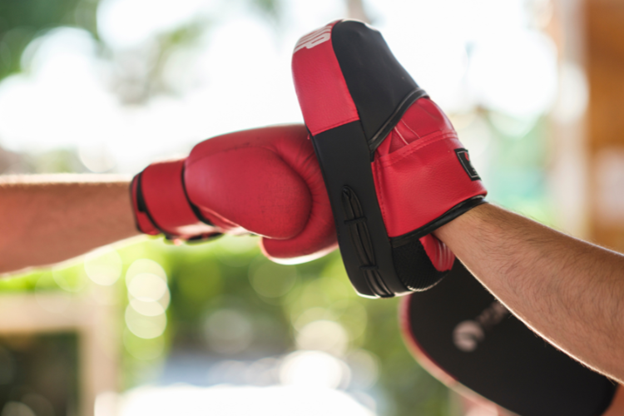Boxing is a powerful and rewarding sport that combines strength, endurance, and skill. While many people associate boxing training with a gym or specialized training space, creating an effective boxing routine at home is absolutely achievable. Whether you’re a beginner or intermediate boxer, you can develop a routine that targets skill improvement, strength building, and conditioning without ever leaving your home.
Setting Up Your Home for Boxing Training
Before you start working on punches and footwork, you need a proper training environment. Having enough space to move around freely is so important to an effective workout. If you don’t have a large space in your home, even a small, clutter-free area can work as long as it provides enough room to move your arms and legs comfortably.
Tips for setting up your home for boxing training:
- Clear Space: Move furniture, breakables, and distractions to create an open area where you can box freely.
- Flooring: Use a non-slip mat or area rug to provide some cushioning. This will help reduce the impact on your joints and make your movements safer.
- Lighting and Ventilation: Ensure you have good lighting and air circulation, especially if you’re training indoors. Proper ventilation is so important to maintaining energy levels and reducing fatigue.
- Soundproofing: If you’re training in a shared space, consider using earplugs or noise-canceling headphones. Boxing involves a lot of movement and noise, so soundproofing your room can be helpful.
You need a living space that is comfortable and conducive to exercise. This is where a platform like SpareRoom can help you find the perfect space, whether you’re looking for boxing-loving roommates in Houston, New York, Boston, or anywhere else in the US.
Crafting a Boxing Routine: Key Components
Once you’ve set up your space, it’s time to focus on creating a balanced boxing routine. A well-rounded boxing workout targets several areas: technique, strength, endurance, and conditioning. Here’s how you can integrate these components into your home training:
1. Skill Development: Mastering the Basics
Boxing is a technical sport, and developing a solid foundation of basic skills is essential. This includes learning proper footwork, hand positioning, punches, and defensive movements.
Shadow Boxing
This is a vital exercise for any boxer. Shadow boxing allows you to practice combinations and techniques in the air, refining your movements without the need for equipment. You can practice basic punches such as the jab, cross, hook, and uppercut, while focusing on your footwork and form.
Start with basic combinations (e.g., jab-cross, jab-cross-hook) and gradually add more advanced combinations.
Focus on keeping proper posture and moving smoothly, visualizing an opponent in front of you.
Footwork Drills
Footwork is the foundation of effective boxing. Practice moving forward, backward, and side to side, ensuring that you can pivot quickly and change directions with ease.
Use cones or small markers on the floor to simulate the distance you would typically maintain in a boxing ring.
Add footwork to your shadow boxing to simulate actual movement while throwing punches.
2. Strength Training: Build Power and Endurance
Strength training will help you develop the power you need for effective punches and overall stamina. A boxer’s body must be strong and agile, capable of withstanding the rigors of a fight while maintaining quickness.
Bodyweight Exercises
A variety of bodyweight exercises can build the muscle groups used in boxing. Focus on exercises that engage the core, legs, and upper body, such as:
- Push-ups (to strengthen shoulders and chest)
- Squats (to build leg and core strength)
- Planks (to improve core stability)
- Dips (to work on the triceps)
Resistance Training
If you have access to dumbbells or resistance bands, incorporate these into your routine. Dumbbell punches or overhead presses can strengthen your shoulders and arms, while squats with weights can improve your leg power.
Core Workouts
A strong core is essential for generating power from your lower body, and boxing requires a lot of rotational movement.
Incorporate exercises such as Russian twists, leg raises, and cable woodchoppers to strengthen your core.
3. Conditioning: Building Stamina for Fights
Boxing is a highly cardiovascular sport, and building stamina is critical. You need to be able to throw punches consistently throughout a round or multiple rounds without losing energy. Cardio exercises help build that endurance.
Jump Rope
This is one of the most classic and effective conditioning exercises for boxers. Jump rope works on your footwork, endurance, and coordination while burning calories.
Start with a basic jump and gradually increase the speed and intensity.
For variation, try double-unders, criss-cross, and other jump rope techniques.
Running and Sprints
Running builds long-lasting cardiovascular endurance, while sprints simulate the high-intensity bursts you’ll need during a boxing match.
Consider interval training with sprints, alternating between running fast and walking to simulate the alternating intensity of boxing rounds.
High-Intensity Interval Training (HIIT)
HIIT involves short bursts of intense exercise followed by a brief rest period. This mimics the start-stop nature of boxing rounds.
Try performing a round of intense exercise like burpees or mountain climbers, followed by 30 seconds to 1 minute rest. Repeat for several rounds.
4. Recovery: Rest and Regeneration
Recovery is often an overlooked aspect of training, but it’s just as important as the actual workouts. Your body needs time to rest and rebuild muscle tissue.
- Stretching: Incorporate dynamic stretching before workouts and static stretching afterward to increase flexibility and prevent injury.
- Foam Rolling: Foam rolling helps release muscle tension and can improve your range of motion.
- Sleep and Nutrition: Adequate rest and proper nutrition are essential to optimize recovery. Focus on getting enough sleep and eating a balanced diet to fuel your body.
Conclusion: The Importance of a Consistent Routine
Building a boxing training routine at home requires dedication, discipline, and the right space. As a beginner or intermediate boxer, focus on developing your skills, building strength, improving endurance, and allowing time for recovery. With the right environment, you can create an effective training routine that fits into your lifestyle.
Whether you’re training for fitness, competition, or just as a hobby, the key to success in boxing is consistency. Keep challenging yourself with new techniques, exercises, and routines, and you’ll see your skills and fitness levels improve over time. The benefits of boxing extend far beyond the ring, offering a full-body workout that enhances strength, agility, and mental focus.



